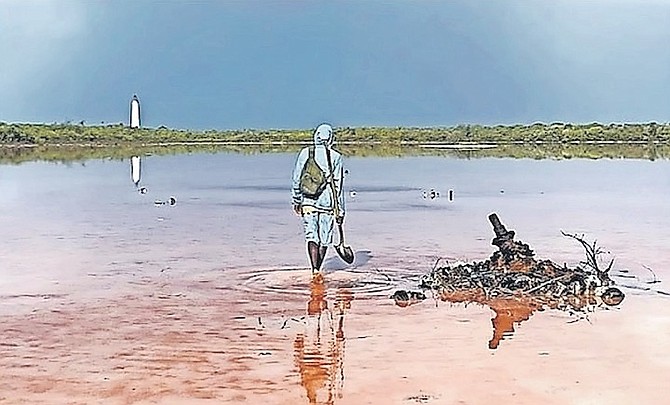Captain Kendrith Williams walks past the engine of Lt Libby’s A-20 Havoc on the lake beneath Castle Island Light, on August 5, 2022, moments after the aircraft was rediscovered 80 years after it crash-landed there, crushing Murray White’s leg beneath its nose when he was ejected. Photo: Eric Wiberg
WHEN the 112-foot Castle Island Light off Acklins was operational, it was a critically important beacon that three World War Two bombers crash-landed near in order to be rescued. This is the story of the first wreck there, which later pilots looking for the ideal place to crash-land described as sitting atop a hard-packed lake on all its wheels. By contrast, the two newcomers were forced to ditch in the sea or the bush, as though it were a game of musical chairs for aviators.
On February 19, 1943 Captain DA Libby of the US Army Air Force was piloting a Douglas A-20B Havoc medium bomber on its journey from Memphis to the Soviet Air Force. His co-pilot was Murray White and navigator JS Veronko. Theirs was the lead plane out of seven that day, flying from Homestead Air Force Base to Puerto Rico, at which none of them arrived that day. Over the Crooked Island Channel Libby, who had 60 hours pilot time on this aircraft, and 1,865 total pilot hours, was told by the other pilots that their right engine was smoking.
The pilot later described how they were “on a foreign mission, destination and purpose secret... the right motor started to cut in and out intermittently and smoke. I discovered an island [Castle] approximately two miles to the left, and proceeded to circle it five times, awaiting developments in engine trouble. While circling, I tried single-engine procedure, and found that I could not keep altitude, so I decided to land.” Before ditching, Libby turned and “asked the navigator, Murray White, to jump [by parachute]. He stated that he would prefer to stay with the ship. I warned him that in previous crack ups of A-20’s the navigator had been dangerously injured because of his exposed position. Lt White still preferred to stay with the ship.”
Twenty minutes after noon Libby says: “I made a normal approach, wheels down, and landed on a dry lake-bed. I cut all electric switches, and proceeded to try to bring the ship to a stop. After running approximately 500 feet over the lake bed, the main [landing] gear suddenly dropped into the mud hole and set the nose wheel into the mud, throwing the navigator, Lt White through the front of the ship.”
As soon as the ship stopped completely, I opened my hatch and jumped down into the mud to extract Lt White from the wreckage. His right leg was caught under a piece of the nose section.” Showing extraordinary strength, Libby and Veronko were able to lift the nose of the aircraft off their colleague’s injured leg and free him, sparing him from drowning, or further injury. The men must have crawled to the edge of the small lake (400 by 225 yards), and spent the night there or along the sea shore which lay just over the berm, the surf audible from the crash site.
The six other planes vectored the US Navy, which sent a patrol craft to the rescue, then returned to Florida. The US Navy submarine chaser USS SC-696 set off from Guantanamo at about midnight. Her hand-written Deck Log for February 20, 1943 records how at 11am they sighted an Allied airplane which signaled course to Castle Island, which they then sighted half an hour later. At 12.45 pm they hove-to [stopped], and hoisted their wherry [a light rowboat for carrying passengers] over the side. Then a crewman named A Kravitz and a helmsman named B Noble rowed the wherry ashore, intending to bring survivors of the wrecked plane back to the sub-chaser.
Indeed, at 1.50pm Noble returned on board with injured survivor Murray White, who was “hoisted aboard and tended to by Doctor.” Just ten minutes later Noble was heading back to shore.
At 2.45pm, Noble returned to ship with pilot Libby and engineer Veronko. Finally, at 3.15pm, Noble returned ashore to pick up his shipmate Kravitz and the survivor’s baggage and papers. At 4pm, Noble and Kravitz returned aboard with the items, and the wherry was hoisted aboard. By 4.20 the same day, less than five hours after arriving USS SC-696 was under way. She docked in Guantanamo at 10.26am the following day, with Murray White being taken ashore at Pier A by stretcher. The aviators were found less than 24 hours after crashing and delivered safely ashore less than 24 hours after that.
The aircraft remained visible for many years, and traces of it can be seen from space today. On September 20, 1943 Captain O’Neil reported in Miami that a “plane had landed on Castle Island in a marshy spot, with its wheels down. All hatches were open, and there were no signs of life about”. For years, Bahamian telephone services also received messages from passing ships such as this one: “...a signal was intercepted from a ship off Inagua reporting that a crashed aircraft had been sighted on Castle Island.”
First Lt James F Hunt had to crash his B-26C Marauder bomber in the bush of the Acklins mainland on April 7, 1943 because, as he told investigators, having run out of fuel “we saw that it would be practically impossible to set the airplane down on the beach, and we saw an A-20 on Castle Island, so we decided the safest thing to do would be to abandon ship”. The startled investigation board asked “You saw an A-20 on Castle Island? How could you tell the type of ship?” To which Hunt replied “Yes, sir. I figured that is what it was.” Indeed, it was Libby’s A20, it’s still there, with periodic sightings by yachtsmen passing through as well.
The board of inquiry summarised the incident thus: “Nature of Accident: Forced landing on a small island off the coast of Acklins Island. Nose section buckled; fuselage wrinkled. Cause of accident: power plant failure.”
Libby suffered only minor injuries, White’s were deemed major, and Veronko’s classed simply as ‘none.’ The panel concluded that “Lt Libby handled his plane and crew in a highly satisfactory manner;” evidently so, since pilots for year have admired his handiwork.
Then, soon after dawn on the rainy morning of August 5, 2022, Captain Kendrick Williams and I disembarked in Mundian Harbour, Castle Island and landed three days’ supplies – tent, kayak, rope, shovels, food and water. Within five minutes of setting off inland from the beach we discovered the large engine from this aircraft sitting atop a pink saline lake, with smaller bits embedded in the salt, which had set like concrete, and fringing the little lake. The plane has been found.









Comments
Use the comment form below to begin a discussion about this content.
Sign in to comment
Or login with:
OpenID